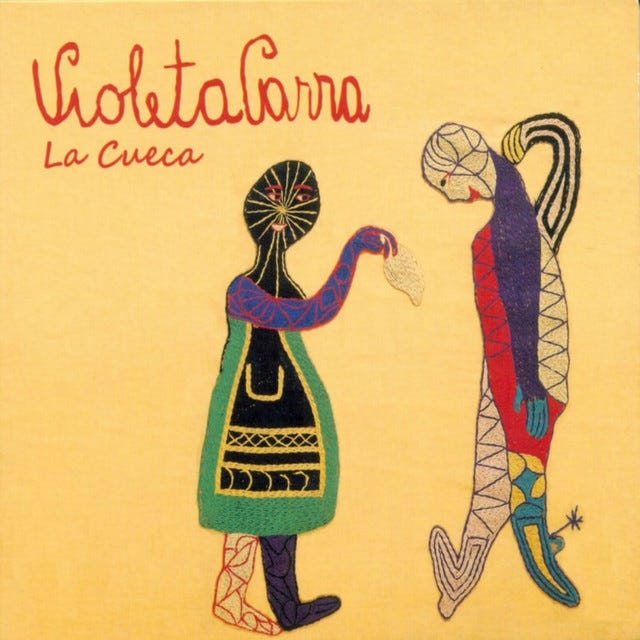EVERY GENRE PROJECT - April 24 - Cueca
Genre of the Day - Cueca
Album of the Day - La Cueca by Violeta Parra (1959)
April 24, 2024
Cursory research into today's genre gave me a boatload of things to stuff into a potential lede. What do you mean by a zoomorphic dance? Why did Chileans have beef with every other bordering country? Where the hell is cueca even from? Questions are great: my curiosity was certainly piqued by today’s genre. There’s always so much more under the surface.
Unfortunately for the Chileans, who are typically most associated with the genre of cueca—hey, at least they get today’s top album—cueca essentially originated in Peru. Its primordial form was known as the zamacueca. Perhaps the truest form of fusion music in Latin America, it is proposed to have its origins in European, African, Andean, and Romani music. It may have originated from the word zamiquiqui in Quechua, which referred to the day of rest after work during the Viceroyalty era of colonial Peru. It also may have originated from the Kimbundu language word zamba. Whatever the origins, it goes to show South America’s particularly robust mixing of musical elements, so incorporated into each other that tracing the steps back is often next to impossible.
Nevertheless, from those obscured origins, cueca traveled a long history. It became a consolidated popular dance in Chile in the early 1800s, where it varied stylistically between cities as they added their unique flair to the hot new dance. And yes, it does involve imitating animals: the romantic dance of the rooster and the hen in particular. It’s lovely to think that people have historically enjoyed observing those strange feathery creatures so much that national dances could be inspired from them. Cueca in Chile does take influence from the original Peruvian zamacueca, but isn’t the exact same form: they will make sure you know this, if my research revealed anything. The beef was serious after Chile instigated war with Peru in the early 1880s in the War of the Pacific. Even by then, the genre had become so synonymous with Chile that it was referred to as the chilena across the Spanish-speaking world. It features an atypical 6/8 time signature and is typically played alongside the guitar.
As much as cueca is the most iconic dance of Chile, Violeta Parra simply elevates today’s album to maximum Chile. The most iconic folk singer from the country, she is to thank for the timeless, haunting “Gracias a la vida.” Sort of like how yesterday’s Estonian folk singer Reet took her country’s folk music to Canada and immortalized them in a new context, Parra breathed new life into traditional dances and pastoral songs in the urban centers of Chile. She was prolific: today’s album alone features nearly 30 numbers. From the romantically mournful like “Adíos Que Se Va Segundo” and its tale of a long-gone sailor to the whimsical “De La Pierna de un Zancudo” recounting a giant emerging from a mosquito, Parra makes cueca gleam using her strong but supple voice that can easily slide into a birdlike falsetto. The 6/8 time signature makes for slightly unfamiliar but joyful, swinging melodies that bring the dance to life even without visuals. As a pronouncement of the joy of home, “En la Cumbre de los Andes” shines with its convivial singing and pronounced guitar strum as she extolls the starry skies of the Chilean Andes. The album is an insistent effort to spotlight a historic tradition while injecting it with enough lyrical intrigue and vocal power to make it timeless. So forget the beef: just enjoy cueca from a dedicated craftswoman.




